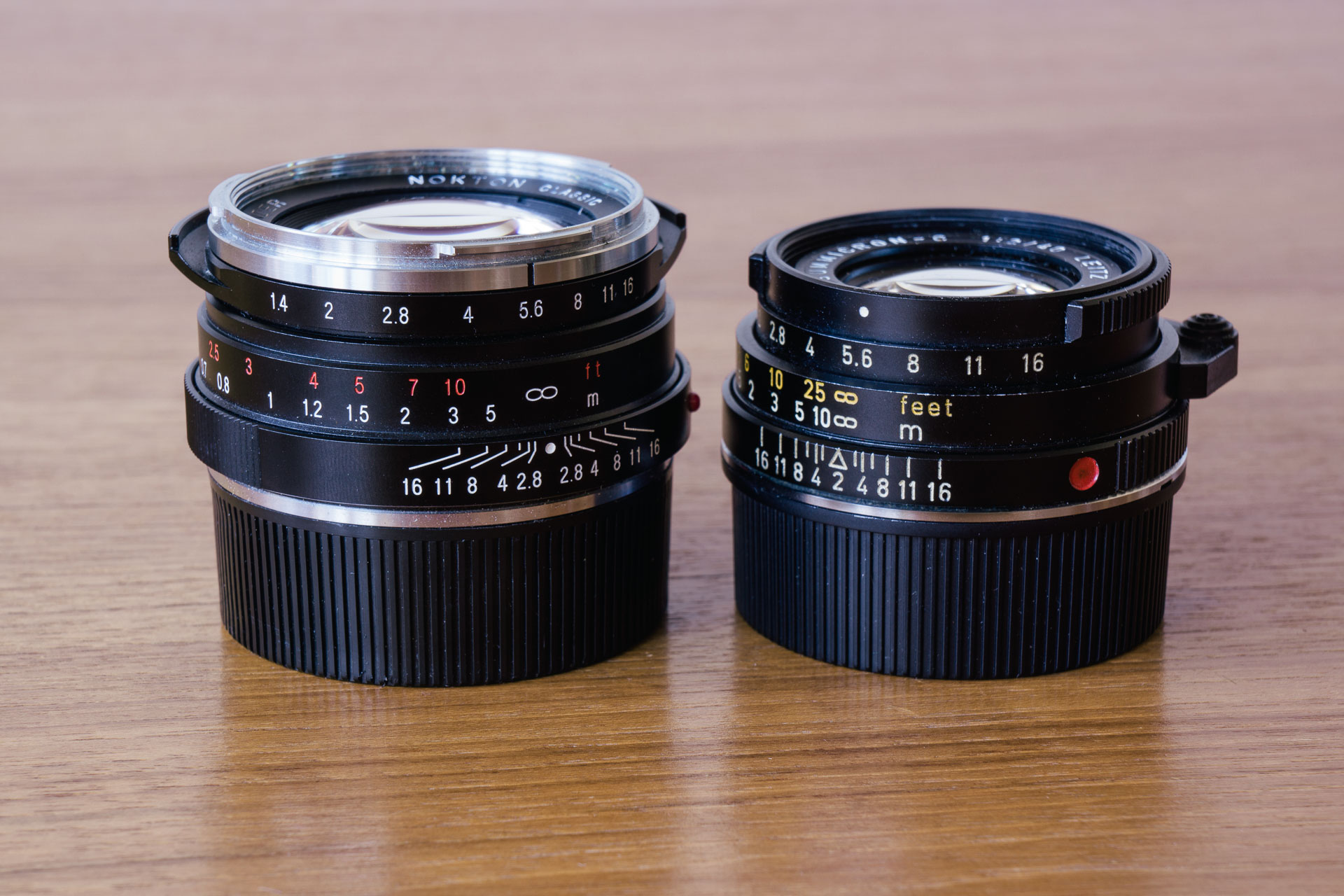
The Voigtländer Nokton 40/1.4 & the Leica Summicron-C 40/2 side by side.
I’m a big fan of 40mm lenses. To me they feel very natural in their perspective and easy to shoot. As it happens I currently own two 40mm lenses for the Leica M-mount. Since there’s relatively little information about how they compare and that much of it is also somewhat inaccurate, I thought I’d do a small comparison.

The Voigtländer Nokton 40/1.4 & the Leica Summicron-C 40/2 side by side.
I prefer to shoot as I usually do and base my technical conclusions on that, but have decided to make an exception in this case. I’ve made a small controlled test comparing the two lenses at varying apertures. Despite having shot both lenses quite a bit previously there were a few surprises in the tests.
I’ll start with the physical and ergonomic differences. I’ll also leave my comments and analysis of the image quality until after the comparison so you are free to form your own opinions. I’ll conclude with my general thoughts on which lens is better.
| Nokton | Summicron-C | |
| Length | 29.7 mm | 23.5 mm |
| Weight | 175g | 127g |
| Diaphragm | f/1.4-f/16 | f/2-f/16 |
| 10 blades | 10 blades | |
| Half stops | Half stops | |
| Elements / groups | 7 / 6 | 6 / 4 |
| MFD | 0.7m | 0.8m |
| Filter thread | 43mm | Series 5.5 |
| Coating | Multi or single | Single |
Comparing the specifications of the two lenses makes a few of the differences immediately clear. The Summicron-C is a tiny and very light lens – the lightest Leica have ever produced for the M-mount.
The Nokton on the other hand is a full stop faster with its large f/1.4 aperture, promising usable results in lower light. While larger and heavier than the Summicron-C the size and weight difference isn’t as substantial as could be expected and the Nokton is still very compact and light.
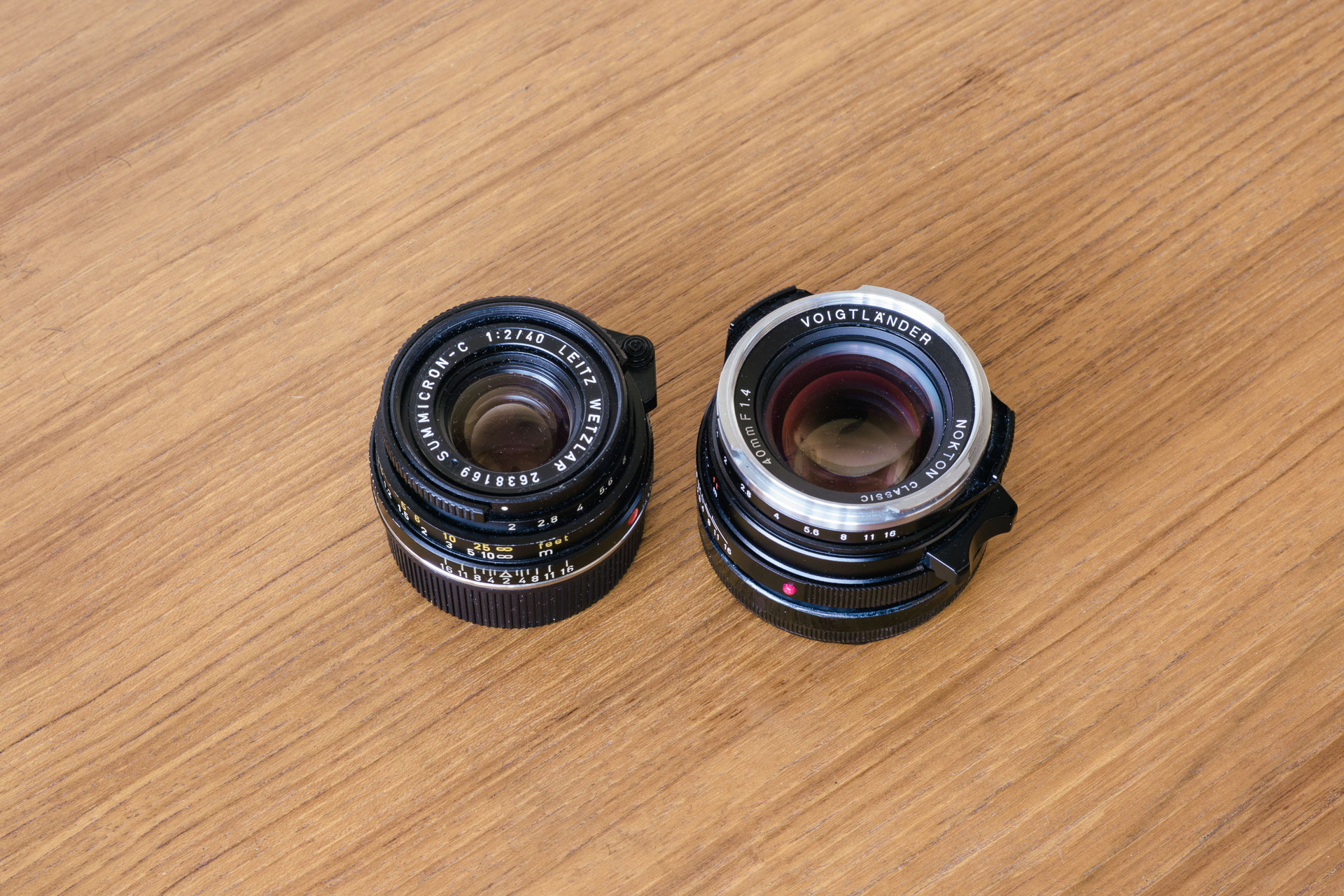
The Nokton & Summicron-C side by side. Note similar size and ergonomic differences.
Comparison with the Leica Summicron 50 V. Note the smaller size of both the full stop faster Nokton & equally fast Summicron-C.
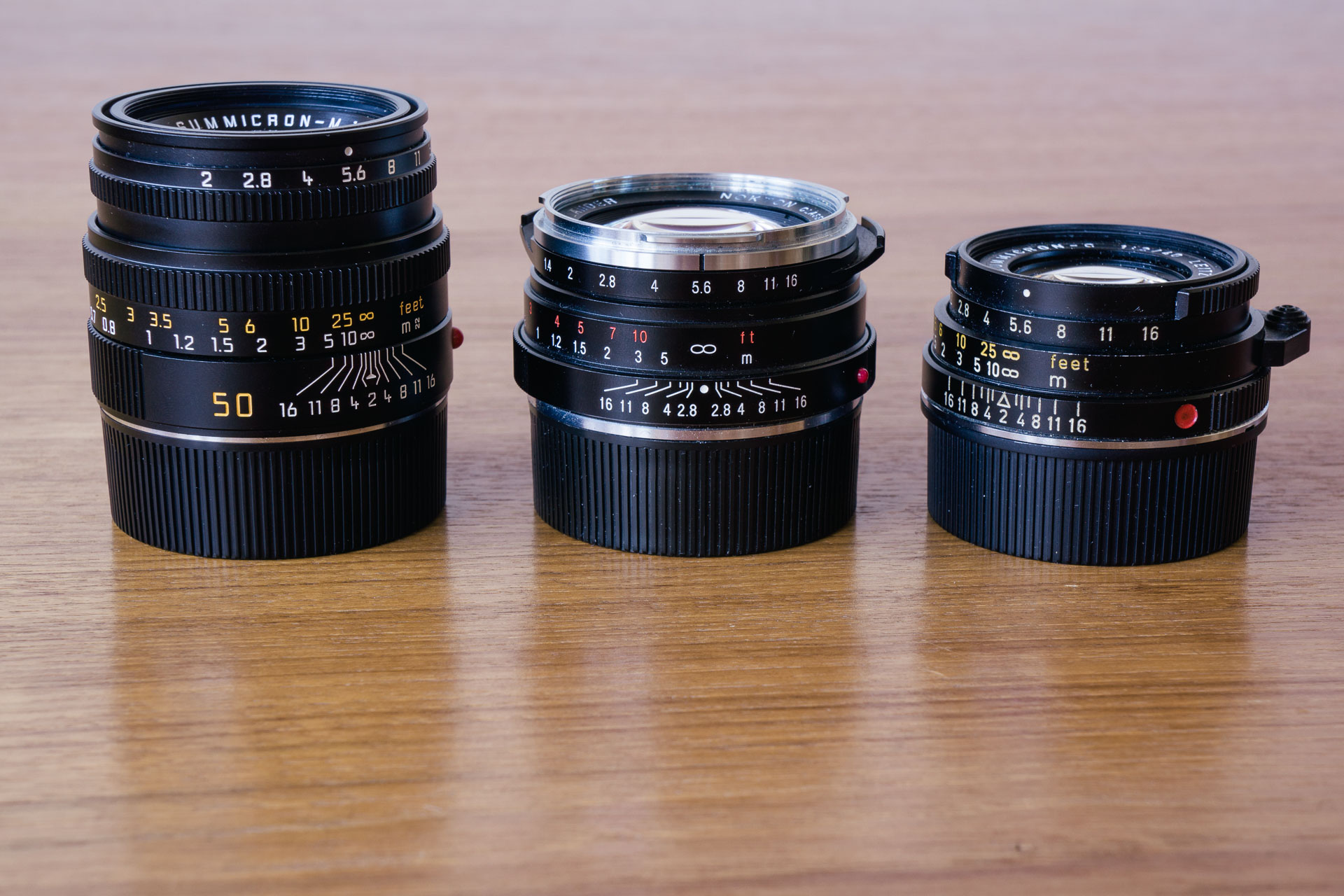
The Summicron-C has a sloped focus cam, possibly resulting in reduced focusing accuracy, especially with older M-mount cameras (I’ve not managed to find any definite information, but it seems like Leica changed the specs for the focus roller on the M6 and later cameras, ensuring that it’s always centred, resulting in accurate focus even with a sloped cam). The Nokton has the conventional perpendicular focus cam and also supports close focus to the modern 0.7m standard.
The Summicron-C has a nonstandard filter thread, making it hard to find and use filters. The Nokton uses a conventional 43mm thread.
The Summicron-C is single coated, the Nokton has Multi coating, but a single coated version is also available as an option.
There’s an issue to be aware of when shooting 40mm lenses on most M-mount cameras – corresponding framelines are usually not available. Only the Leica CL and Voigtländer Bessa R3M/A have them. On most M-mount cameras 50mm framelines are displayed instead. 35mm framelines would be a closer match. On most Leicas a different set of framelines can be temporarily shown using the spring loaded automatic frameline preview lever. Another alternative is to file down the frameline index pin on the rear mount, making the camera recognize the lens as a 35 instead. I’ve left the pin untouched on my lenses, instead framing liberally using the 50mm framelines and manually bringing up the 35mm ones when I’ve wanted higher accuracy. In practice there have been a few rare occasions when this approach has felt a bit fiddly, but generally it works well.
Worth mentioning is that the Nokton also has close sibling – a 35mm lens with almost identical ergonomics, similar specifications and performance but without the framelines issue. An option to consider for most Leica cameras.
The Nokton is still available new at just slightly more than the used price of the Summicron-C. The used prices are comparable.
As for ergonomics, the Nokton has a concave focussing tab made of metal, the Summicron-C a small plastic handle. The Summicron-C has an aperture ring with a ~120° cut out, the Nokton has smaller, protruding handles on its ring, slightly harder to find but easier to set by feel. Aperture stops on the Summicron-C are evenly spaced throughout the range, on the Nokton the stops are longer apart wide open and become gradually closer between f/4 and f/16. I prefer the overall ergonomics of the Nokton.
Below are the test shots. All shot on a Leica M9 with correction profile turned off. White balance has been manually set to the same temperature so that transmission differences can be seen. Shutter speeds were manually set and exposure has been equalised. No vignetting correction, sharpening or other adjustments have been made.
The first test is a mid range distance with the main purpose of showing across the field performance and color rendition differences. Focus was manually set to 5 meters on both lenses. Note that the Nokton is actually focused very slightly farther away, the difference is visible in the wide aperture crops. Such is life without live view.
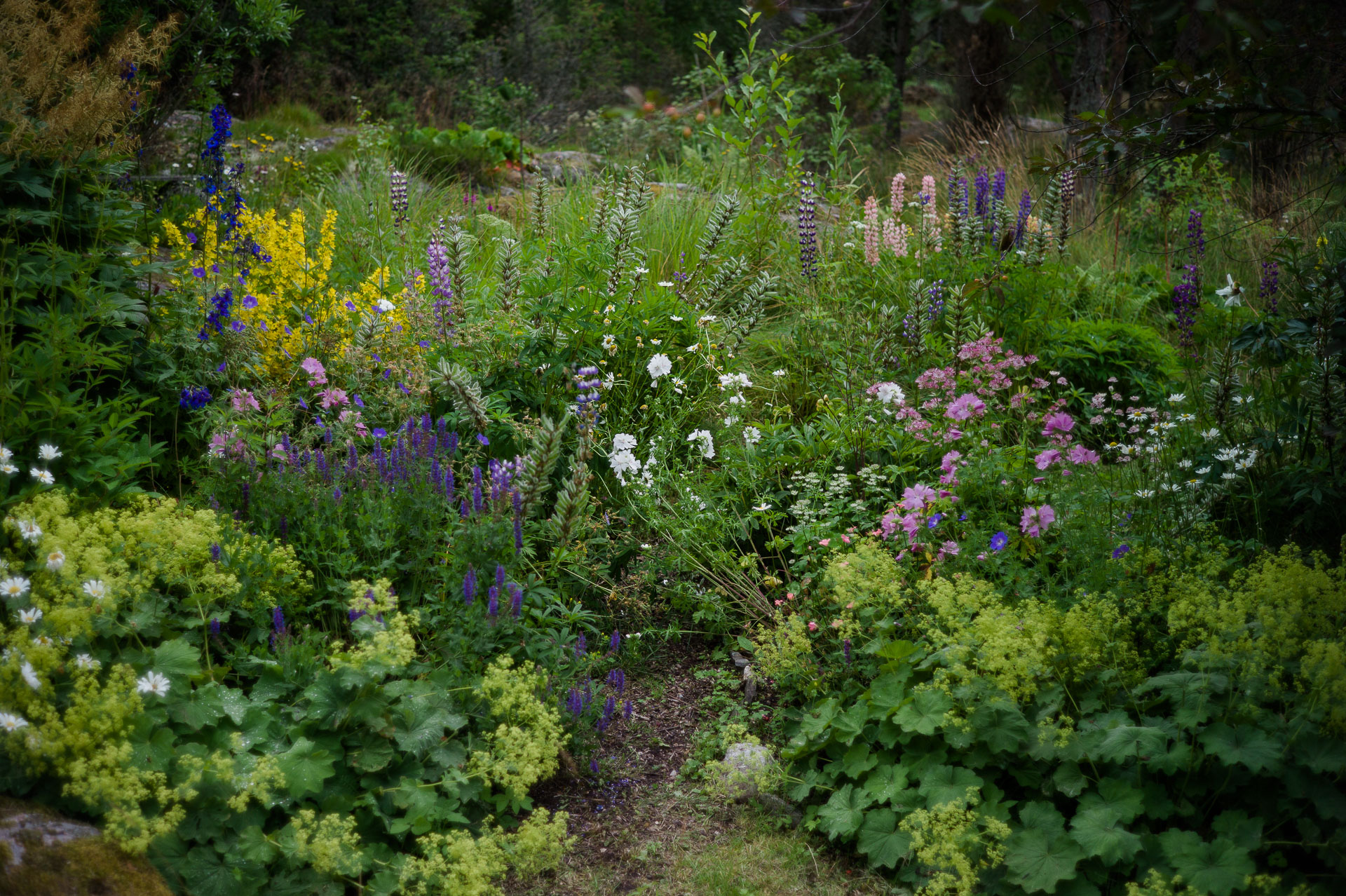
Above the scene is shown. Below are centre, mid-field and corner crops. The Nokton crops are to the left, in the column labeled V for Voigtländer. The Summicron crops to the right, labeled L for Leica.
| V | L | |
| f/1.4 | 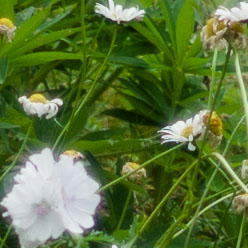 |
|
| f/2 |  |
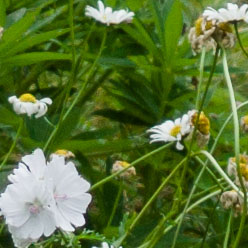 |
| f/2.8 |  |
 |
| f/4 |  |
 |
| f/8 |  |
 |
| V | L | |
| f/1.4 |  |
|
| f/2 |  |
 |
| f/2.8 |  |
 |
| f/4 |  |
 |
| f/8 |  |
 |
| V | L | |
| f/1.4 |  |
|
| f/2 |  |
 |
| f/2.8 |  |
 |
| f/4 |  |
 |
| f/8 |  |
 |
Full size images:
Voigtländer Nokton 40mm at aperture: f/1.4 | f/2 | f/2.8 | f/4 | f/8
Leica Summicron-C 40mm at aperture: f/2 | f/2.8 | f/4 | f/8
This second test demonstrates differences in bokeh, focus fall off and general performance at short focus distance. Both lenses were focused manually using the rangefinder. The distance is very close to the 0.8m mfd of the Summicron-C.
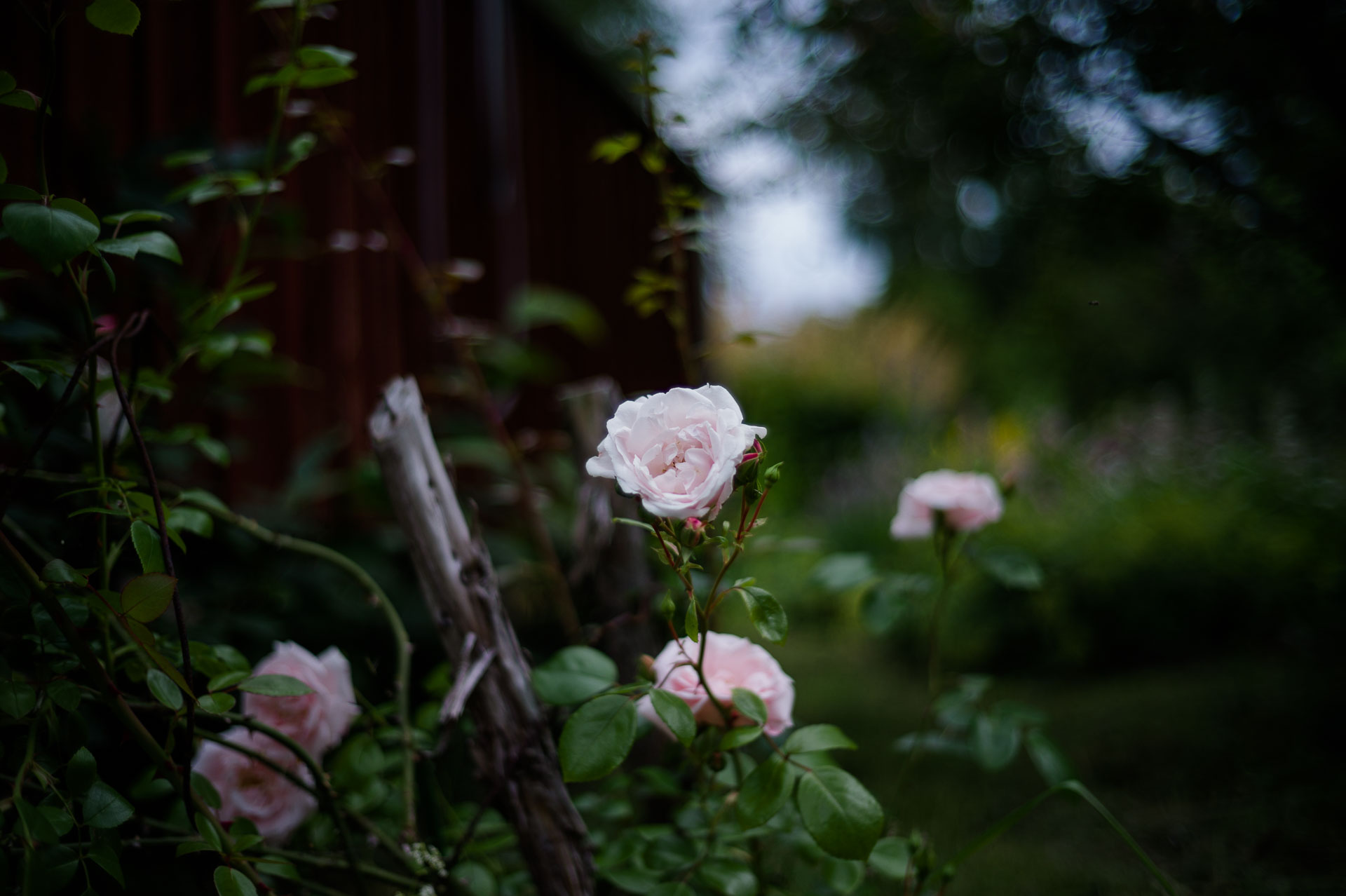
Above the scene is shown. Below are centre, mid-field and corner crops. The Nokton crops are to the left, in the column labeled V for Voigtländer. The Summicron crops to the right, labeled L for Leica.
| V | L | |
| f/1.4 |  |
|
| f/2 |  |
 |
| f/2.8 |  |
 |
| f/4 |  |
 |
| f/8 |  |
 |
| V | L | |
| f/1.4 |  |
|
| f/2 |  |
 |
| f/2.8 |  |
 |
| f/4 |  |
 |
| f/8 |  |
 |
| V | L | |
| f/1.4 |  |
|
| f/2 |  |
 |
| f/2.8 |  |
 |
| f/4 |  |
 |
| f/8 |  |
 |
Full size images:
Voigtländer Nokton 40mm at aperture: f/1.4 | f/2 | f/2.8 | f/4 | f/8
Leica Summicron-C 40mm at aperture: f/2 | f/2.8 | f/4 | f/8
Common knowledge indicate that the Summicron-C is a superior lens with higher optical performance and smoother bokeh. In my eyes, these tests refute that notion. I’m actually surprised at how close they perform. Each have slight advantages to the other but it’s at a fairly academic level – both are mostly great but neither is flawless or pulls clearly ahead.
Let’s go through the results, shall we.
First things first – since I equalised exposure something that can’t be seen in the above images but can be found in the RAW files is that the Nokton transmits slightly more light than the Summicron-C despite having more elements. Since the test was made outdoor some variance is to be expected, but the slight difference in brightness is visible in every image. The T-stop of any shared F-stop is about quarter to a third of a stop brighter on the Nokton than on the Summicron-C. Visible and advantageous but not very significant.
Another immediately visible difference is that the Nokton is slightly longer. A difference of perhaps 2–5mm of focal length. Vignetting is slightly higher in the Summicron-C. Gone in both lenses by f/4. Both have slight distortion with the Nokton showing a bit more.
I expected to see some differences in colour response but the variations are so small I’m hard pressed to tell them apart even in this side by side test. The Nokton is slightly warmer, pulling very slightly towards yellow, or the Summicron-C pulls towards blue. The variance is within a few hundred Kelvin and both are within neutral bounds. Equalising white balance colours look identical. It’s possible that very subtle colour differences can be seen in different light or on a camera with better colour separation. In these conditions, on the M9, no differences can be seen.
While flare isn’t evaluated in these tests I know from experience that the Nokton with its more modern coatings is better by far than the Summicron-C which is very sensitive to oblique light and high contrast scenes.
Wide open performance is obviously better in the Summicron-C, but that disregards the difference in speed. The Nokton’s extra stop comes in handy when performance across the frame is less important than light gathering.
Looking at the Nokton’s f/1.4 performance specifically I’d call it appealing and very useable but not optimal. Resolution on axis is very good, but drops quickly across the field. Contrast is fair. Spherical aberration leads to a clear glow. Corner performance is poor. There’s probably some wavy field curvature and possibly astigmatism making the resolution uneven and slightly unpredictable across the frame, this characteristic is reduced but remains stopping down. Vignetting is significant and using the same shutter speed only the centre darkens when stopping down to f/2. Bokeh is poor at f/1.4, especially in the more challenging areas of higher contrast, explaining the Nokton’s reputation in that regard. In conditions with calmer backgrounds the overall look can be very pleasant however.
Comparing both lenses at f/2 they are almost indistinguishable. The resolution and contrast on axis is equal and impressive in both lenses. Both lose a lot of definition in the mid field and are poor in the corners. The Nokton has slightly less even resolution than the Summicron-C but has higher micro and mid level contrast. Close range performance is also extremely similar. The Nokton’s transition from in and out of focus is marginally more abrupt and better defined resulting in slightly more apparent subject isolation. Bokeh is somewhat of a surprise – while the Nokton is still slightly harsh in the high contrast areas it’s quite gentle overall and far better than the Summicron-C.
Stopping down to f/2.8 the similarities continue. Mid field and edge performance is increased to good levels on both lenses with corners still lacking definition. The Summicron-C is still more even and the Nokton is slightly more crisp. Focus shift affects the Nokton, with peak performance being pushed slightly backwards. Without sufficiently extended depth of field to cover the shift results in lower performance at the actual focus distance. At close focus the shift is large enough as to result in lower performance at f/2.8 than at f/2. I actually avoid shooting the Nokton at f/2.8 at close distances because of this, opting for f/2 or f/4 instead. The Summicron-C shows no focus shift with depth of field extending expectedly. Bokeh is still slightly smoother from the Nokton, but has improved markedly from the Summicron-C, now almost too close to tell.
Performance at f/4 is almost indistinguishable. Resolution and contrast across the field is now excellent from both lenses with only the very deep corners lagging slightly. At close range performance of the Nokton still suffers slightly from focus shift, but is now less visible due to larger depth of field. Field curvature and focus shift makes the Nokton slightly less consistent in the mid range test than the Summicron-C. Bokeh is still better on the Nokton, but by a very small amount.
Stopped down to f/8 performance is practically perfect in the mid range test. Impressive showing by both lenses – not all compact, high speed designs manage to improve to these levels stopped down. The Summicron-C is better by a nose with more even performance and slightly better definition of small details. Bokeh is almost identical.
All in all I feel both lenses have admirable performance considering their moderate size, good specifications and low price. The Summicron-C has more even and predictable performance. The Nokton has a very usable extra stop and better light gathering overall, smoother bokeh and better flare control.
Because of their respective strengths and similar performance it’s impossible to name a clear cut winner between the lenses. It depends on ones priorities and preferences.
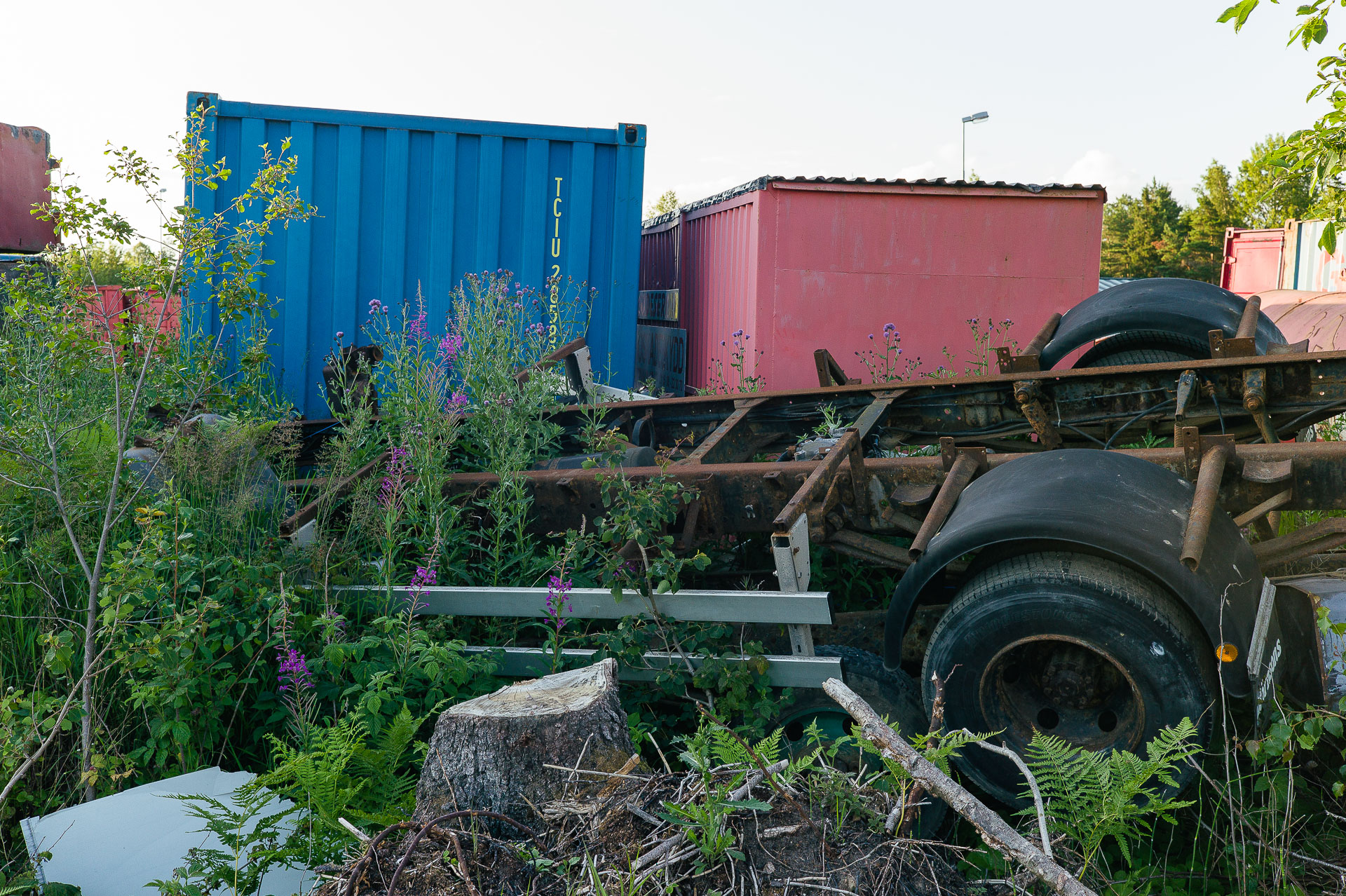

One is taken with the Nokton, the other with the Summicron-C. Can you tell which is which? Of course not – so many other things affect an image more in practice than the academic differences between these two lenses. Pick either and get out and shoot.
Pick the Summicron-C if you…
Pick the Nokton if you…
The bottom line is that I've made several photographs I really like with both lenses. Most shots could've been made with either lens without visible differences to the end result. While I very slightly prefer the rendering of the Summicron I would probably pick the Nokton due to its better ergonomics and the usable extra stop, but at the end of the day both are fantastic lenses and you can’t really go wrong with either.
All photos in this post were taken using the Leica M9 and Voigtländer Nokton 40/1.4 or Summicron-C 40/2.